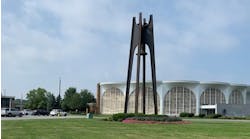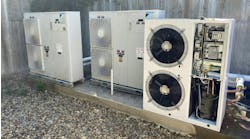BY STEVE SPAULDING
OF CONTRACTOR'S STAFF
DENVER — In case you haven't been to Utah lately, the Mormons have been busy. The Church of Jesus Christ of Latter-day Saints had an estimated 12 million members in 2004, and it is one of the fastest-growing churches in the world.
That means construction. From places of worship to welfare centers to educational facilities, museums and libraries, the LDS Church builds according to time-tested, multi-phase plans that would impress the largest multi-national companies. The church is not only its own design firm, it's also project manager, general contractor, facilities manager and client.
It does, however, bid out jobs to various subcontractors. As part of expanding one of its facilities in Denver, the LDS Church needed to convert the heating system from steam to hydronic heat, and the winning bidder was ACA --Denver Boiler.
The contractor — it's full name is Air Conditioning Associates - Denver Boiler, but more than 50% of its work is tied to hot water, steam heat and fan coil systems — has been in business since 1972. Principles include founder and owner John Sweeny, current business partner Jim Smith, and service and accounts manager and self-described "lead gofer" Kelly Hessel.
The company employs from 15 to 20 people depending on workload. Hessel described the company as primarily a service contractor.
"We'll do replacement and repair 90% of the time," he said. "New construction is something we do much less."
ACA - Denver Boiler is a union shop, and it has a good union to work with, Pipefitters Local 208, Hessel said.
"A union shop here in the city is usually a quality shop," said Hessel, a pipefitter himself by training. "We have very high education levels with the guys on the service side ... part of their pay scale is actually tied to how many hours of training they do each year."
The union acts almost as a personnel office for the company, able to scan their ranks for techs with particular skill sets, then forward their resumes along to various contractors such as ACA - Denver Boiler.
For the LDS expansion, the job entailed removing a 40-year-old, low-pressure, atmospheric-fired, 20-section cast-iron boiler.
"It filled the mechanical room," Hessel said. "It was practically wall-to-wall boiler."
In addition, a huge, suspended heat exchanger on the ceiling was running the existing hydronic part of the building. It was using steam to heat the hot water in the fan coils to heat the building — an inefficient setup that all had to go.
As a replacement, ACA - Denver Boiler installed two high-efficiency Pennant boilers by Laars, each with a capacity of 1 million Btu and efficiencies of 85%.
"Pennant is actually considered a fan-assist atmospheric boiler, which uses atmospheric venting," Hessel said. "But they use a fan on the out-side blowing in to regain your pressure loss on the combustion side. That helps a lot."
Particularly in the Mile High City: The rule of thumb is that heating appliances lose 1% efficiency for every 1,000 ft. above sea level. Also, most appliances are rated on 1,000 Btu/cu. ft. of gas — but the natural gas in Denver only as 840 Btu/cu. ft. (again because of the elevation) — a loss of 16% from the get-go. But fan-assisted combustion can help reclaim almost all of that loss.
To get more space out of the mechanical room, a frame was built and the boilers stacked one on top of the other. A variety of venting options on the boilers helped simplify the installation, and because the job involved direct combustion, Hessel was able to meet Denver's strict relief air requirements by venting directly to the outside.
Of course, no battle plan survives the first engagement. Unanticipated problems included having to run lines the length of a gymnasium to get to some fan coils, and some coil units that needed to be re-piped and have new coils put in.
"It turns out you could no longer purchase coils the correct size for those old Trane units," Hessel said. "We had to have some fabricated — but the pricing was close enough."
For controls, the boilers use tekmar technology to do outdoor reset. They also sense their water supply temperature as well for internal staging. Tekmar controls were used for switching the lead/lag on the pumps.
"We used Grundfos pumps," Hessel said, "which is something I really like. They make these pumps that have three speeds depending on how you change a little module in the cover. We've found that by using the modular controls we can usually run at a lower speed than the original GPM specified for the system. If you drop the speed of your head by 20%, you use only half as much power to run it. That's one of the big savings of variable frequency drives."
The job took about three weeks to complete and paid $84,000. The system is just finishing its second heating season.
While the first winter with the system worked out well, problems cropped up in the second heating season when some settings were changed. A valve failed and needed to be replaced, and another three-way valve had some control problems.
"The heated area would get a little too warm when it was occupied," Hessel explained. "The system would go into a cooling mode, and the heating coils go, 'Hey! We're still in a heating mode!'"
It was a simple matter of not having the right control specs for the situation, and it was easily fixed. Now the church members gather in comfort, while ACA - Denver Boiler has moved on to its next challenge.

